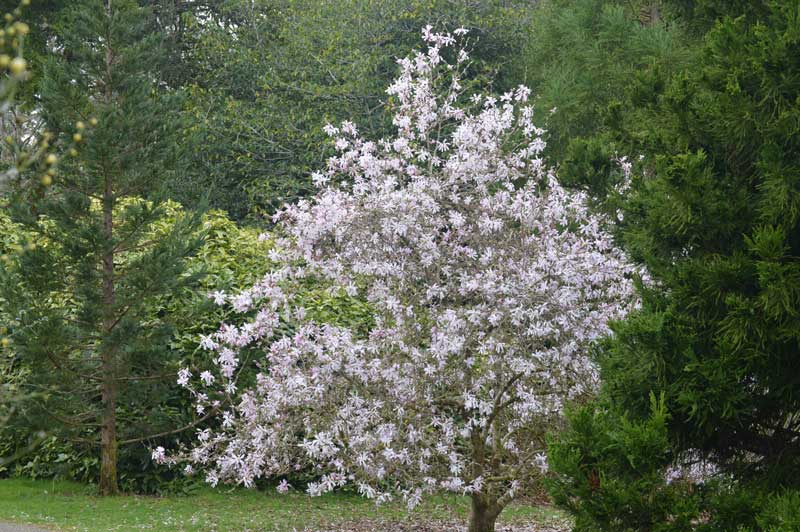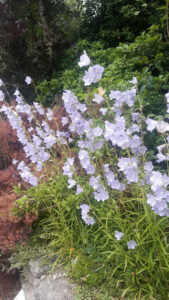Gardening
with Charlie Wilkins
BLOSSOMS AND BULBS
Blossoms and bulbs herald the opening days of May, but by the middle of the month their thunder is stolen by the magnolias and in particular the variety ‘Stellata’ which takes on the look of a white bridal hat, joining the riot of blossom on the almonds and ornamental cherries in neighbouring gardens. Their flowers creep up on you like nasal hairs -nothing one day, then there they are right before your eyes! To ignore them is impossible. On naked branches, Stellata’s star-shaped, pristine white blooms look wonderful, filling dull spots and drab corners alike, (light shade suits them admirably) in much the same way as snow does. This variety is certainly one of the very best for a small garden and it comes not alone in the white described, but also with a pink flush! An even finer, more upmarket magnolia called liliiflora is freely available and this too is shrub-like in growth habit and nicely shaped for confined spaces. It also has generous sized blooms which look like slender Maytime tulips, deeply maroon on the outside and cream within, the perfect combination for small gardens with houses or bungalows faced with either fancy brick or pebble-dashed walls. In a word, it oozes distinction and if you value your property, you’ll want to invest in one of these. If you cannot find plain liliiflora, then look for liliiflora nigra for it is equally as good in a maroon purple colouring. Both flower for a very long period, often starting in April and continuing to the end of May if not longer. Bear in mind that most magnolias bloom for only three weeks or so and you have to live with the tree for the remainder of the year.
Take your time choosing. They are not cheap (even as small plants) and the bigger they come in their pots, the more expensive they become. Buy large if at all possible, and if you are over 50, buy doubly large! There’s not much use in having to wait years perhaps for your purchase to achieve full flowering potential. I’m not saying they take this long to bloom, certainly not the smaller garden kinds I have mentioned. When you do buy, splash out another few pounds on a good soil enricher and dig this in before planting and staking. What kind of foolish gardener would €30 for a dark-flowered, specimen magnolia and then skimp on enriching the soil with a few quid’s worth of goodness?

THE MAY GARDEN 2022
CUCKOO: This is the weather the cuckoo likes, and so do I, but the days and nights are still cold (as I write) and our winged visitor from South Africa has yet to be spotted. However, the shadows continue to shorten and the church spire, which, since early autumn has acted like a sundial genome, no longer casts a spire-like image across the tarmacadam grounds. The slim outline of a tall Thuja at the gateway (normally slow to show its magnificence) is now resplendent in its summer finery and it too, casts a shadow barely larger than its overall height. In the lawn grass-growth has increased with the timid rise in temperature, and cutting can now commence on a weekly basis. The problem with grass clipping has always been one of disposal, for too much at a time, added to the compost heap, produces a sodden slimy mass which smells to high heaven and draws millions of tiny flies. As well, it weeps a continuous trickle of evil-looking fluid which can stain and burn in a trice. Always mix other materials (even shredded newspapers) with grass clippings before adding to the compost heap.
OUTDOOR FUCHSIA
Cut back all outdoor fuchsias immediately, going down to within nine to twelve inches of the soil. When finished, scatter a little bone-meal fertiliser or similar about their positions. Scratch this into the soil and before long fresh new growth (if not already visible) will become evident. Both ‘Genii’ (with golden foliage and typical fuchsia-coloured blooms) and ‘Versicolour’ (ash-grey and rose pink leaves) will please the most discerning gardener. Celia Smedley is my all time favourite even though it is not fully hardy. All of these in the company of hydrangeas will come to perfection for both together make good neighbours excelling in the half light conditions of shade gardens.
TOPICAL TIP
Gladioli are very easy to grow from corms planted now in deep fertile soil which is free-draining above all else. Place the corms about 6” deep with about the same distance between each but do not mix the varieties. Choose the ‘butterfly strains’ if you want something really grand and good-looking but there are others in the family well worth having as well. Apart from the buxom “Dame Enda Everage” types, elegant new species are freely available. Examples include G. callianthus (formerly acidanthera murielae) with white, scented, pendant flowers and G. papilio with small nodding flowers flushed with mauve. This latter variety is invasive in my garden but I hang onto it (for its distinctive colouring) just the same. All need a sunny position, but only the large-flowered hybrids need staking as they grow.
TIME FOR TOMATOES
Once again I cannot stress too strongly the value one will get from a basket variety of tomatoes sourced from Dooley’s Garden Centre. Bought now and kept frost free until hanging-out time later this month, the investment will give small, sweet fruits from the end of June through to the closing days of October. Give full sun, water diligently especially in dry periods, and feed weekly with any tomato food.







